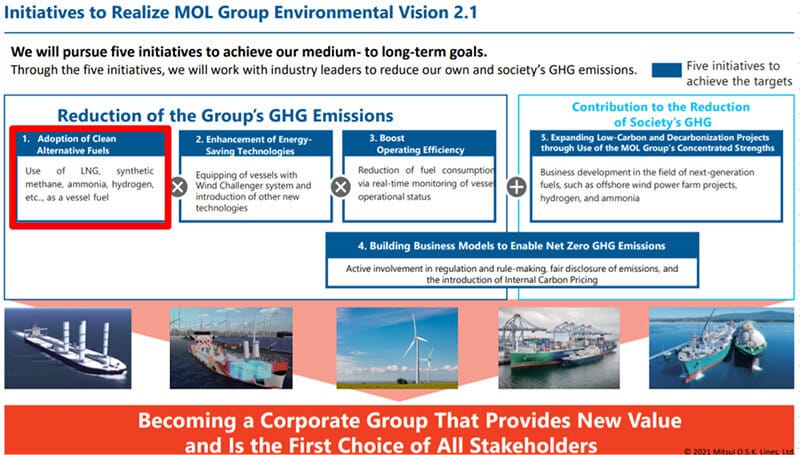
[ad_1]

Mitsui O.S.K. Lines, Ltd. (MOL) announced the conclusion of a syndicated “Transition Loan” (Note 1) for two LNG-fueled ferries: the Sunflower Kurenai and the Sunflower Murasaki.
The Development Bank of Japan Inc. (DBJ) and Sumitomo Mitsui Trust Bank, Limited (SMTB) served as the arrangers and Sumitomo Mitsui Banking Corporation (SMBC) as the co-arranger. On top of the three banks, this Transition Loan was jointly provided by 10 local financial institutions located mainly in Western Japan, near the routes on which the two ferries will be launched, and close to the shipyards where they will be built. It was selected as the first transition loan in Japan for the Ministry of Economy, Trade and Industry (METI)’s climate transition model projects.
Eligibility for the loan received a third-party evaluation by the Japan Credit Rating Agency, as the loan conforms to the Climate Transition Finance handbook published by the International Capital market Association (ICMA) and the Green Loan Principles (GLP) developed by experienced working groups such as the Green Bond Principles (GBP) of the International Capital Market Association.

Image Credits: mol.co.jp
The two vessels are Japan’s first LNG-fueled ferries, which will be operated on the Osaka-Beppu route by MOL Group company Ferry Sunflower Limited (President: Mitsujiro Akasaka: Head Office: Oita-shi, Oita Prefecture), and slated for launch in succession from the end of 2022 to early 2023.
LNG, which will be used as fuel on the ferries, is expected to reduce the vessels’ emissions of carbon dioxide (CO2) by more than 20%, sulfur oxides (SOx) by 100%, and nitrogen oxides (NOx) by about 85% compared to conventional fuel oil vessels. The ferries have also earned the top rating of five stars from the Japanese Ministry of Land, Infrastructure, Transport and Tourism’s (MLIT) energy conservation rating system for coastal ships. These vessels are also expected to contribute to a modal shift in Japan in addition to playing a key role in a critical maritime infrastructure that supports the movement of people and commodities in Western Japan.
The MOL Group established the MOL Group Environmental Vision 2.1 in June 2021 with the aim of achieving net-zero GHG emissions by 2050. It plans to launch about 90 LNG-fueled vessels by 2030, as an “introduction of clean alternative fuels” (Fig. 1) to realize this vision. It continually strives to contribute to the development of a through concerted group-wide efforts.
[Vessel Profiles]
| Names/Delivery | Sunflower Kurenai : December 2022 Sunflower Murasaki : March 2023 |
|---|---|
| Shipyard | Mitsubishi Heavy Industries Shimonoseki Shipyard |
| Passenger capacity | 714 |
| Loading capacity (trucks) | 136 units (in conversion with 13m) |
| Speed | 22.5 knots |
| Length | 199.9m |
| Gross tonnage | About 17,300 tons |
[Outline of Syndicated Transition Finance]
| Borrower | MOL |
|---|---|
| Arrangers | DBJ and Sumitomo Mitsui Trust Bank, Limited |
| Co-arranger | Sumitomo Mitsui Banking Corporation |
| Transition structuring agent | DBJ and Sumitomo Mitsui Trust Bank, Limited, Sumitomo Mitsui Trust Bank, Limited |
| Agent | Sumitomo Mitsui Trust Bank, Limited |
| Lenders | DBJ and Sumitomo Mitsui Trust Bank, Limited, Sumitomo Mitsui Banking Corporation, Yamaguchi Bank, Ltd., Higo Bank, Ltd., Oita Bank, Ltd., Kitakyushu Bank, Ltd., Yokohama Bank, Ltd., San-in Godo Bank, Ltd., Hiroshima Bank, Ltd., Iyo Bank, Ltd. Ehime Bank, Ltd., Kyoto Bank, Ltd. |
| Purpose of the loan | Build 2 LNG-fueled ferries |
| Third-party evaluation organization | Japan Credit Rating Agency |
(Fig.1)

Image Credits: mol.co.jp
(Note 1)
Transition Loan is a commitment line with the purpose of supporting corporations that engage in reduction of greenhouse (GHG) gases in line with long-term transition strategies to realize a de-carbonization society as set out in the goals of the Paris Agreement
Reference: mol.co.jp
Japan’s First 2 LNG-Fueled Ferries To Be Operated By MOL’s Subsidiary appeared first on Marine Insight – The Maritime Industry Guide
[ad_2]
This article has been posted as is from Source